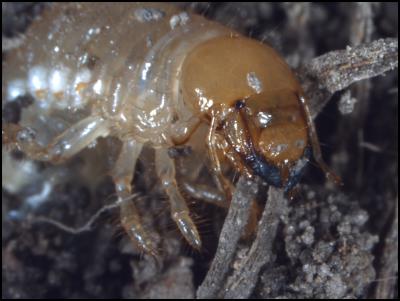Smell of success: insect pests avoid boosted pasture grasses

New Zealand native grass grub (Costelytra zealandica)
Media Release
17 December
2014
- for immediate release
The smell of success: insect pests avoid boosted pasture grasses
A recent study from the Bio-Protection Research Centre has shown for the first time that pasture grasses containing beneficial microorganisms are less attractive to soil-dwelling insect pests.
Most New Zealand ryegrass and fescue pastures contain beneficial microorganisms that live within the grass shoots. These fungal endophytes are key to the country’s healthy grasslands. In return for food and shelter the endophyte can help its host grass resist insect attack, survive droughts, and even protect against overgrazing.
Insect pests are attracted to plants by odour as they can smell minute amounts of chemical compounds that tell them if a plant is damaged or healthy. Now researchers in New Zealand from Lincoln University, AgResearch and the University of Otago have shown that, when colonised by endophytes, the chemicals released by the grass are different, and this can deter insect pests in the soil from feeding on plant roots.
The study showed that grass grubs, a major grassland pest throughout New Zealand, preferred to feed on the roots of grasses without endophytes, and that the insects appeared to be responding to the smell of specific types of compounds (known as volatiles) that are released by the plants.
“The endophyte is only present in the shoots, not the roots; however, we found the roots produce less volatiles and so fewer grubs came to feed on them,” says Dr Michael Rostás, a senior lecturer at Lincoln University and lead researcher on the recent paper.
While previously shown to affect the above ground feeding of insect pests, this novel finding reveals that endophytes that inhabit only the shoots and leaves can also affect feeding below ground.
“Our data suggests that protection is a two-step process where grass grubs are less attracted to plants with endophytes in the first place. Those that do feed on the roots will eventually be deterred by the fungal toxins,” says Dr Rostás.
This research used the latest mass spectrometry technology at the University of Otago, which can detect very low amounts of airborne chemicals. The fact that such sophisticated equipment is needed highlights just how sensitive insects’ antennae are.
More research is necessary to see whether other combinations of grass and endophyte have the same effect, and if this can be used to combat grass grub damage on farms.
This research is available online in the Oecologia journal and will appear in print early next year.
End
About the
Bio-Protection Research Centre
The
Bio-Protection Research Centre is a Centre of Research
Excellence funded by the Tertiary Education Commission. It
was established in 2003 to drive innovation in sustainable
approaches to pest, pathogen and weed control. The Centre
has five partner institutes: AgResearch, Lincoln University,
Massey University, Plant & Food Research and Scion, with
members throughout New
Zealand.


 NIWA: 'Now Or Never' - Fight Against Invasive Clam Gets Critical Boost
NIWA: 'Now Or Never' - Fight Against Invasive Clam Gets Critical Boost The Reserve Bank of New Zealand: RBNZ Releases Updated Financial Stability Indicators
The Reserve Bank of New Zealand: RBNZ Releases Updated Financial Stability Indicators Asia Pacific AML: NZ Has Never Exercised Governance Over Threats From Trans-National Criminals; Easy To Facilitate Trans-National Crime
Asia Pacific AML: NZ Has Never Exercised Governance Over Threats From Trans-National Criminals; Easy To Facilitate Trans-National Crime Trade Me Property: Auckland House Prices Hit Four-year Low, Dropping Below One Million
Trade Me Property: Auckland House Prices Hit Four-year Low, Dropping Below One Million AgResearch: New Funding For ‘Smart Ideas’ To Address Challenges For Primary Sector
AgResearch: New Funding For ‘Smart Ideas’ To Address Challenges For Primary Sector Forest and Bird: Hoiho Wins Bird Of The Year 2024
Forest and Bird: Hoiho Wins Bird Of The Year 2024



